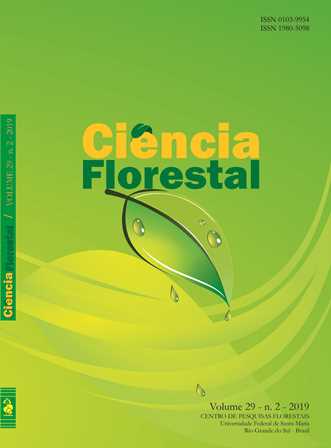Computational simulation of mixing devices in combustion chamber for carbonization gases
DOI:
https://doi.org/10.5902/1980509827196Keywords:
Biomass, Charcoal, Atmospheric emissions, Environmental constraintsAbstract
Charcoal from planted forest represents a renewable energy source used by steelmaking in Brazil. However, the pyrolysis gas released from carbonization is characterized by a low lower heating value. The sustainability of charcoal production has demanded the combustion of pyrolysis gas, which can represent an environmental constraint. In this paper, different mixing devices were evaluated for a combustion chamber, a system that allows mitigating the environmental impacts of carbonization, use of thermal energy in the wood drying and electric power generation. An existent combustion system was analyzed and used as a reference to calibrate a computational fluid dynamics model. The input data for the model were gas composition, gas flow rate and its temperature. The model considers the differential equations of mass, momentum, energy and chemical species conservation, and it was used for the study of different mixing devices for gas burning. Among the devices studied (AC), the AC5 was more effective in the use of the entire chamber volume, resulting in a lower dead zone percentage and a longer residence time of gases (5% more), when compared to the device used in the reference system. The volume fraction of CO and O2 distribution and flow streamlines into the combustion chamber allows concluding that internal mixing devices are necessary for a better mixture between fuel and oxidizer and, consequently, to produce gas combustion with better quality.Downloads
References
ABNT - Associação Brasileira de Normas Técnicas. Incineração de resíduos sólidos perigosos - Padrões de desempenho, Norma NBR 11175, Rio de Janeiro, 1990.
ASSOCIAÇÃO BRASILEIRA DE PRODUTORES DE FLORESTAS PLANTADAS - ABRAF. Anuário estatístico da ABRAF: ano base 2012. 145f. Brasília, 2013. Disponível em: http://www.ipef.br/estatisticas/relatorios/anuario-ABRAF13-BR.pdf. Acesso em: 11 nov. 2016.
BRITO, J. O. Princípios de produção e utilização de carvão vegetal de madeira. Documentos Florestais. Instituto de Pesquisas e Estudos Florestais, 1990, Vol. 9, p. 1-19.
CHOHFI, R. M. Discussion of the routes and potential for dimethyl ether production from the biomass available in the sugarcane value chain. Energy for Sustainable Development, v. 12, p 62-64, 2008.
CARDOSO, M. T.; DAMASIO, R. A. P.; CARNEIRO, A. C. O.; JACOVINE, L. A. G.; VITAL, B. R.; BARCELOS, D. C. Construção de um sistema de queima de gases da carbonização para redução da emissão de poluentes. Cerne, Lavras, v. 16, Suplemento, p. 115-127, jul. 2010.
COELHO, M.P. Desenvolvimento de metodologia para o dimensionamento de câmaras de combustão para gases oriundos do processo de carbonização de madeira. 2013. 78f. Tese (Doutorado em Engenharia Agrícola) – Universidade Federal de Viçosa. Viçosa, MG. 2013.
CETESB - COMPANHIA AMBIENTAL DO ESTADO DE SÃO PAULO . Dutos e chaminés de fontes estacionárias - determinação dos pontos de amostragem: procedimento, L9.221. São Paulo, 1990.
CONAMA - CONSELHO NACIONAL DO MEIO AMBIENTE. Resolução CONAMA Nº 316, Brasília, 23 de outubro de 2002. Disponível em: <http://www.mma.gov.br /port/conama/legiabre.cfm?codlegi=338>. Acesso em: 11 nov. 2016.
GOMES, A. F.; PEREIRA, E. G.; MARTINS, M. A.; CARNEIRO, A. C. O. Desempenho de uma câmara para a combustão de gases provenientes do processo de carbonização da madeira. In: III Fórum sobre Carvão Vegetal, 2014, Belo Horizonte. Anais: Sociedade de Investigações Florestais, [2014]. CD-ROM.
INDÚSTRIA BRASILEIRA DE ÁRVORES. Indústria Brasileira de Árvores - Relatório Estatístico 2015. 100 f. São Paulo, SP, 2016. Disponível em: http://iba.org/images/shared/Biblioteca/IBA_RelatorioAnual2016_.pdf. Acesso em: 11 nov. 2016.
LIU, B.; WANG, Y. H.; XU, H. Mild combustion in forward flow furnace of refinery-off gas for low-emissions by deflector. Applied Thermal Engineering, v. 91, p. 1048-1058, 2015. Disponível em: http://www.sciencedirect.com/science/article/pii/S1359431 115008741. Acesso em: 22 nov. 2016.
LUZ, F.C.; ROCHA, M.H.; LORA, E.E.S.; VENTURINI, O.J.; ANDRADE, R.V.; LEME, M.M.V.; OLMO, O.A. Techno-economic analysis of municipal solid waste gasification for electricity generation in Brazil. Energy Conversion and Management, 2015. Disponível em: http://dx.doi.org/ 10.1016/j.enconman. 2015.06.074. Acesso em: 22 abril 2017.
PEREIRA, E. G.; MARTINS, M. A.; PECENKA, R.; CARNEIRO, A. C. O. Pyrolysis gases burners: Sustainability for integrated production of charcoal, heat and electricity. Renewable and Sustainable Energy Reviews, 2016. Disponível em: http://dx.doi.org/ 10.1016/j.rser.2016.11.028. Acesso em: 05 abril 2017.
SILVA, J. G. Addressing Food Security Challenges under Increasing Demand for Land, Soil and Energy. In: Global Forum for Food and Agriculture, 2015, Berlin. Federal Ministry of Food, Agriculture and Consumer Protection (BMEL). Berlin: BML, 2015. Disponível em: http://www.fao.org/about/who-we-are/director-gen/faodg statements/ detail/en/c/275129/. Acesso em: 11 nov. 2016.
THAKKAR, J.; KUMAR, A.; GHATORA, S.; CANTER, C. Energy balance and greenhouse gas emissions from the production and sequestration of charcoal from agricultural residues. Renewable Energy, v. 94, p. 558-567, 2016. Disponível em: http://www.sciencedirect.com/science/article/pii/S0960148116302713. Acesso em: 11 nov. 2016.
VILLETTA, M. L. et al. Modelling approaches to biomass gasifcation: a review with emphasis on the stoichiometric method. Renewable and Sustainable Energy Reviews, Amsterdam, v. 74, p. 71-88, 2017.







